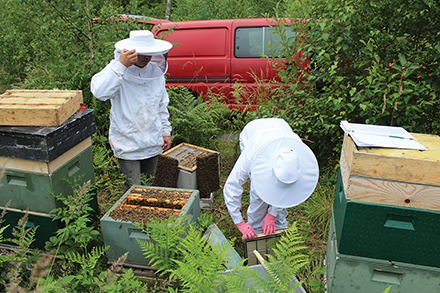
What would happen if all beekeepers simply stopped trying to control varroa mites? Well, there would likely be a massive worldwide population crash of the managed western honey bee (Apis mellifera). And in the process, there would likely be an epidemic of viruses that spilled over from collapsing honey bee colonies into the numerous species of wild bees and other insects that are susceptible to those same viruses. Without exaggeration, halting varroa controls could result in a worldwide pollinator health and beekeeping catastrophe.
But what then? Would Apis mellifera go extinct? Probably not, since there are already several isolated populations of A. mellifera that get along just fine without treatments for varroa Thus, there are already western honey bee populations that have evolved to control varroa on their own. And not only that, the way in which each of the populations control varroa is strikingly similar. This is the intriguing topic of our ninth “Notes from the Lab,” where we highlight “Rapid parallel evolution overcomes global honey bee parasite,” written by Melissa Oddie and colleagues and published in the journal Scientific Reports [8:7704 (2018)].
Wait, there are several isolated populations of A. mellifera that get along just fine without treatments for varroa? Yes, you read that correctly. Oddie and colleagues highlight four of these “surviving populations” in their study – one population from Oslo, Norway, another population from Gotland, Sweden, and two populations from Avignon and Sarthe, France. Each of the populations has survived for >17 years without a single varroa treatment. And that’s probably just the tip of the iceberg. Other recent publications have shown that treatment-free Apis mellifera populations are present in South America and at least three states in the eastern United States.
The presence of these “surviving populations” that persist in the face of varroa suggests the bees have figured out how to control varroa on their own. In only a few decades or less, evolution via natural selection has resulted in genetic lines of Apis mellifera that keep varroa at low enough levels that they don’t overrun the colonies.
Fantastic, how do the “surviving populations” do it? This is the main focus of Oddie and colleagues’ study. To figure this out, the authors made a few astute observations. First, they compared the number of reproductive mites in brood cells from the “surviving” compared to “susceptible” colonies from the same geographic areas. They found that reproductive success of the mites in “susceptible” colonies was 10-30% greater, on average, than reproductive success in the “surviving” colonies. In other words, varroa was much better at reproducing in the normal colonies that weren’t from the isolated “surviving populations” that had presumably undergone natural selection.
Second, they noticed the frequency of uncapping and recapping of brood cells was significantly greater in the “surviving” colonies. And not only that, the….


